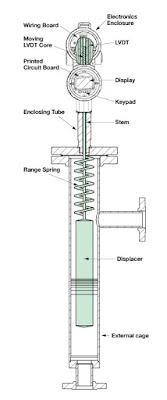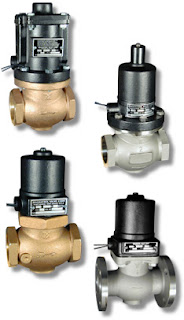A blog specializing in pressure, temperature, level and flow instrumentation, control valves, process analyzers, and all other areas of process measurement. Courtesy of Miller Energy, a New Jersey, New York, Pennsylvania, and Ohio process instrumentation Rep and Distributor.
Showing posts with label Eastern Pennsylvania. Show all posts
Showing posts with label Eastern Pennsylvania. Show all posts
V-Cone® Flow Meter Conditions Flow For Accurate Measurement
Accurate measurement of fluid flow is a process requirement in many industrial operations. There are numerous methods employed in the measurement of fluid flow, of which the McCrometer V-Cone® is one entry with very particular advantages. Whether the application involves liquid, steam, or gas, this flow meter design, with its own flow conditioning built in, provides exceptional differential pressure flow measurements in a space saving format.
The video provides a clear illustration of how the V-Cone® design conditions fluid flow in order to provide better DP measurement performance. Share your flow measurement challenges with application specialists, combining your process expertise with their depth of product application knowledge to develop effective solutions.
Electronic Displacer Liquid Level Transmitter - How it Works, When to Use It
 |
| Electronic displacer liquid level transmitter using spring technology Courtesy Magnetrol |
Magnetrol, a globally recognized leader in the design and production of level measurement instrumentation, describes the operating principle of their Digital E3 Modulevel® displacer level transmitter:
Electronic displacer level transmitter technology operates by detecting changes in buoyancy force caused by liquid level change. These forces act upon the spring supported displacer causing vertical motion of the core within a linear variable differential transformer.
The movement of the core within the LVDT generates an electrical signal which is further processed and serves as the output of the transmitter. The unit is designed to be externally mounted on a tank. Isolation valves are recommended.
The spring technology employed as a counterforce to the buoyancy of the displacer results in a stable signal that is not impacted greatly by vibration, agitation, or turbulence of the measured liquid.
The video below provides more detail, covering the features and advantages of this level measurement technology and the Magnetrol instrument. Share your level measurement challenges and requirements with a product application specialist. The combination of your process knowledge and their product application expertise will produce effective solutions.
The spring technology employed as a counterforce to the buoyancy of the displacer results in a stable signal that is not impacted greatly by vibration, agitation, or turbulence of the measured liquid.
The video below provides more detail, covering the features and advantages of this level measurement technology and the Magnetrol instrument. Share your level measurement challenges and requirements with a product application specialist. The combination of your process knowledge and their product application expertise will produce effective solutions.
Tank Blanketing Valve Function and Useful Features
 |
| Tank Blanketing Valve Caschco - Valve Concepts |
Often, the gas employed to fill the vapor space in a tank is nitrogen. The purpose of blanketing can vary, but generally involves preservation of the stored product or safety. In both cases, one goal is to keep oxygen levels in the vapor space sufficiently low to inhibit ignition of flammable products, or minimize oxidation and its impact on stored product quality. The inflow of blanketing gas can also be used to keep the tank under positive pressure relative to the surrounding space, considered to harbor contaminants which could otherwise leak into the tank.
What are some functions of a tank blanketing valve?
- Maintain positive pressure in the tank at a selected setpoint.
- Provide gas control at very low flow rates, or close bubble tight, when tank liquid level is static.
- Adjust gas flow to compensate for the maximum liquid draw down rate.
- Provide sufficient closure to prevent supply gas from excessively pressurizing tank.
Blanketing valves are used in conjunction with vents to provide a full range of control over the pressure and content of the vapor space within a tank. A single valve solution eases the design and component selection burden of amassing individual components and combining them into a working assembly. Some useful features of a blanketing valve include:
- Bubble tight shutoff to prevent wasting of purge gas.
- Self cleaning flow path design.
- Pressure balanced pilot, so supply pressure fluctuations do not impact the setpoint.
- Setpoint not appreciably affected by changes in temperature.
- Low maintenance requirements, including complete access to valve internals without removing the valve from the tank.
More detail, including a description of the elements required for proper valve sizing, is found in the document below. Share your fluid process measurement and control challenges with application specialists, combining your process experience and knowledge with their product application expertise to develop effective solutions.
Solenoid Valves - The Operational Basics
 |
| Industrial Solenoid Valves Magnatrol |
At the basic level, a solenoid is an electromagnetic coil and a metallic rod or arm. Electrical current flow though the coil produces a magnetic field, the force of which will move the rod. The movable component of the solenoid is linked to, or part of, the operating mechanism of another device. This allows the switched electrical output of a controller to regulate mechanical movement in another device and cause a change in its operation. A common solenoid application is the operation of valves.
A plunger solenoid contains a movable ferrous rod, sometimes called a core, enclosed in a tube sealed to the valve body and extending through the center of the electromagnetic coil. When the solenoid is energized, the core moves to its equilibrium position in the magnetic field. The core is also a functional part of valve operation. It's repositioning causes a designed changed in the valve operating status (open or close). There are countless variants of solenoid operated valves exhibiting particular operating attributes designed for specific types of applications. In essence, though, they all rely on the electromechanical operating principle outlined here.
A solenoid valve is a combination of two functional units.
- The solenoid (electromagnet) described above.
- The valve body containing one or more openings, called ports, for inlet and outlet, and the valve interior operating components.
The document provided below illustrates a portion of the broad array of solenoid valves available for industrial control applications. There are also some good cutaway illustrations showing the internal operating valve parts. Share your valve requirements and challenges with an application specialist. Combining your process application knowledge with their product expertise will produce effective solutions.
Succeeding: Engineer as Peacemaker
 |
| Make Allies, Not Adversaries |
Let's take a step away from the technical, but still focus on an important aspect of our work.
As engineers involved in process measurement and control, we are accustomed to everybody else looking to us for answers and solutions. We are the people that make things work. Occasionally the pressure and stress can get a little intense and strip away some of our civility in our dealings with those around us. You may have bitter experience with this as either victim or perpetrator. It never ends well. With a private and candid self-assessment about how we view and interact with other stakeholders in our projects, we may be able to scale down some of our stress and better focus on the reality of the task at hand. Consider the points below. Comment and add a few points of your own.
You are an expert, but so are they.
Everybody else's job usually looks easier than it really is.
All jobs have their own special challenges and responsibilities that generate stress. Accept the notion that you probably do not fully comprehend the burdens on those around you. Your portion of the project is certainly critical, but no more so than that of anybody else. Everybody needs to perform or nobody succeeds. Try not to view your project tasks as compartmentalized, but rather as part of the combined joint effort of all stakeholders. Help out others whenever you can. Again, make allies.
Everybody is somebody's customer.
Whomever you deliver your work product to is your customer. The people delivering their work to you should view you as their customer. Make your customers happy by adjusting aspects of your procedures to better satisfy their needs. In a more technical sense, your modified process output becomes an improved input to their process. Small changes in your delivery may produce comparatively large returns in customer satisfaction. Allies.
Do not embarrass or demean others...especially in public settings.
Embarrassment breeds anger, a desire for revenge, and other bad and unproductive things. Avoid words and deeds that will make a coworker or stakeholder look bad in front of others. If there is a problem, if there is a mistake, try to deal with it discreetly whenever possible. Giving a someone a chance to repair a mistake before it becomes public builds value in your relationship. Certainly, there can be instances where more is at stake than someone's pride. Use good judgement to recognize when you can privately give someone an opportunity to amend a situation without causing harm.
Reach a common understanding of project scope and technical details
It's not about being right. It's about being successful.
At our company we recognize customers are more than merely people that buy things from us. They are people to whom we contribute our time and talent to help achieve their success,... which inevitably will lead to ours. Never hesitate to let us know how we are doing, or how we can help.
Miller Energy - Industrial Instrumentation and Process Control Solutions
Miller Energy is a Manufacturer's Representative and Distributor of industrial instrumentation and process control equipment. Miller is committed to exceeding customers expectations by providing an unparalleled level of customer service and local technical support.
Miller offers the most comprehensive line of measurement, control, and communication solutions in industry today. The products provided by Miller solve challenging applications in the industrial gas, power, refining, chemical / petro-chemical, food & beverage, water/wastewater, and pharmaceutical markets.
Welcome to the Process Measurement, Instrumentation and Control Blog, sponsored by Miller Energy
Welcome! We hope (over time) you find this blog interesting to visit and it becomes a trusted resource for process measurement and control. We plan on weekly educational and informative blog posts innovative process control solutions, insight to how industrial controls work, and new products that solve tough engineering challenges. Please come back often!
Subscribe to:
Posts (Atom)
